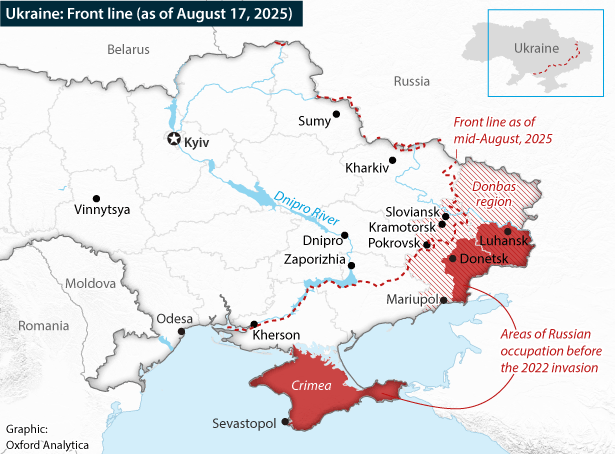Washington has backed Moscow’s call for a peace deal not a ceasefire, reigniting the threat of an end to US aid for Kyiv
The August 15 Alaska summit between US President Donald Trump and Russian President Vladimir Putin has moved US policy from securing a ceasefire in Ukraine to a peace deal close to Moscow’s maximalist demands. Putin has scored a tactical victory without offering any concessions. Trump seems willing to entertain demands unacceptable to Kyiv while refusing to exert leverage on Moscow. He has put the onus on Ukraine and Europe to deliver a swift peace.
What’s next
Ukrainian President Volodymyr Zelensky and select European leaders will meet Trump today, seeking to prevent the White House from endorsing Moscow’s position. Russia is likely to intensify military operations to strengthen its negotiating hand while staying open to talks on a final settlement. For Ukraine, survival now hinges on maintaining Western unity amid the twin perils of a forced peace on Russia’s terms, and an irreplaceable Washington quitting the fight.
Subsidiary Impacts
- Moscow will seek to link any deal over Ukraine to a broader renegotiation of the European security architecture.
- Oil prices are unlikely to rise, as the threat of new US sanctions on buyers of Russian oil has receded.
- Russian forces will continue to make steady gains on the battlefield as talks continue.
- Putin’s apparent triumph may consolidate elite cohesion in Moscow.
Analysis
The US-Russia summit in Alaska may mark a significant juncture in the trajectory of the Ukraine war.
While pre-summit speculation suggested that Trump might extract tangible concessions from Russia under the threat of increased sanctions, Putin not only held firm to his pre-existing demands but successfully reshaped the terms of the discussion.
The encounter revealed a strategic gulf between the US and European approaches to the war, while also demonstrating Putin’s ability to manipulate his relationship with Trump to Russia’s advantage.
The meeting
By welcoming Putin to Elmendorf Air Force Base — the first US-Russia summit on American soil since the Cold War — Trump bestowed on his counterpart a degree of legitimacy many in the West had sought to deny him since the February 2022 invasion. For Moscow, this broke Western efforts to isolate Putin and confirmed Russia’s status as a first-rank power, with Trump treating Putin as an equal.
Trump’s “red carpet welcome” for Putin contrasted sharply with the frostiness that has marked some of his interactions with Ukrainian President Volodymyr Zelensky (see UNITED STATES: Ukraine U-turn is part of wider shift – February 20, 2025).
Substantive talks between the two leaders and their teams lasted nearly three hours — considerably shorter than the seven hours mooted by Moscow in advance of the summit. During the short press conference that followed, Trump declared that “many points were agreed to” but acknowledged that no final settlement had been reached on Ukraine.
Seemingly Putin did not offer any concessions but he extracted several from Trump. He successfully pressed the argument that the “root causes” of the war — NATO enlargement and Ukraine’s Western alignment — must form the basis of any settlement. This framing shifts the focus away from Russia’s aggression and onto the international security architecture, effectively legitimising Moscow’s long-standing grievances (see RUSSIA: Putin weighs options against costs and gains – February 16, 2022).
Putin described the discussions as an “understanding” and pressed Europe not to obstruct the process through “backroom dealings”, again stressing the need to address the “root causes” of the war. This repeats long-standing demands such as Kyiv’s renunciation of NATO membership and the nebulous call for “denazification” — a formulation widely seen as implying regime change in Ukraine.
Subsequently, it was reported that Putin is willing to accept the existing contact line in southern Ukraine as the basis for a settlement, but in the east he wants the entirety of Donetsk and Luhansk oblasts — a strategic prize that his armed forces are far from achieving.
A shift in the US position?
For the moment, Trump appears to have been persuaded by Putin’s core arguments. He endorsed Putin’s position that ceasefires are often unreliable and hence negotiations should aim directly for a comprehensive peace deal. This runs counter to Kyiv’s central demand — a ceasefire, to halt Russian offensives, before talks on a settlement begin. That is a tactical victory for Putin.
In a subsequent Fox News interview, Trump appeared to push responsibility for ending the war onto Kyiv, saying it was now “up to President Zelensky to get it done.” He also suggested that Ukraine’s European allies must “get involved a little bit”, indicating a desire to remove Washington from the next steps of negotiations, rather than lead them.
An invitation was immediately extended to Zelensky to meet with Trump at the White House today, which Zelensky accepted. The night before the planned meeting, Trump stated on a Truth Social post that Zelensky “can end the war with Russia almost immediately”.
European countermoves
Alarmed at the summit’s outcome, European leaders moved quickly to bolster Ukraine. A coalition including France, Germany, Italy and the United Kingdom, plus the European Commission, rallied to support Zelensky ahead of his meeting with Trump in Washington.
Their focus is twofold:
- to press for credible security guarantees for Kyiv; and
- to resist territorial concessions in the Donbas.
Several European leaders are expected to join Zelensky in Washington. They are eager to avoid a repeat of the acrimonious, damaging exchanges between Trump and Zelensky in the Oval Office in February. They have coalesced into a “Coalition of the Willing” determined to extend political and military support for Ukraine in any post-conflict scenario.
Russian gains
From Moscow’s perspective, Anchorage delivered several strategic dividends.
- It undermined Kyiv’s diplomatic leverage by reopening fissures in the Western alliance.
- It enabled Putin to present himself domestically as a statesman who had not yielded on core demands — including a Ukrainian withdrawal from the Donbas and a rejection of NATO membership.
- It reinforced the “time-buying” strategy that has characterised Russia’s diplomatic approach since 2022, allowing it to extend its battlefield gains while discussions stall (see RUSSIA: Military advances will shape peace talks – August 13, 2025).
Crucially, Putin repositioned a ceasefire as an outcome of negotiations, rather than a precursor, and one that is contingent on Ukrainian capitulation. In doing so, Moscow has secured freedom of action on the battlefield while maintaining the appearance of being open to diplomacy.
Implications for Kyiv
For Ukraine, the Anchorage summit represented a serious setback. Zelensky appears likely to come under renewed pressure to consider territorial concessions, particularly in the Donbas.

Ukraine has heavily fortified Donbas since 2014. Relinquishing control over the area is unthinkable for any Ukrainian leader. Its loss would leave the rest of Ukraine extremely vulnerable to any future Russian attack.
Zelensky would likely lose power quickly if he were even to consider ceding the region without cast-iron security guarantees from NATO. Putin knows this, which is why the demand is likely intended to be rejected and to leave Zelensky appearing to be the obstacle to peace.
Europe to the rescue?
Zelensky’s best hope is that his European allies can persuade Trump to recast the conclusions of the Alaska summit in ways that prevent Russia from constraining Ukraine’s sovereignty or limiting its defence capabilities.
Their objective will be to prevent Trump from pressing Zelensky to make hefty concessions in the coming days and weeks, while ensuring that the failure to secure peace does not result in the US president cutting all support for Ukraine.

Activists dressed as US.President Donald Trump (L) and Russian President Vladimir Putin pose after ripping up a map of Ukraine at a demonstration in front of the Brandenburg Gate on August 14, 2025 in Berlin, Germany (Sean Gallup/Getty Images)
Analyst

Richard Connolly

